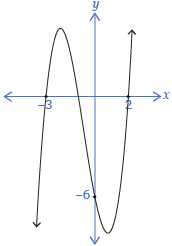Module 3: Lesson 1
Self-Check 4
-
- f(x) = (x + 3)(x − 2)(x + 1)
Step 1: Determine the end behaviour by looking at the degree of the polynomial and the sign of the leading coefficient.
There are three factors containing x; therefore, the expanded form of the polynomial is of degree 3. The degree of the polynomial is odd and the polynomial has a positive leading coefficient. This means the graph will start in quadrant 3 and end in quadrant 1.Step 2: Factor the polynomial if it is not given in the problem.
In this case the equation is already factored.Step 3: Determine the x-intercepts by looking at the factors of the polynomial.
The x-intercepts are x = −3, 2, and −1.Step 4: Determine the y-intercept by substituting zero into the function.
The y-intercept occurs at the point (0, −6).Step 5: Determine the nature of the x-intercepts (whether there is a sign change) by looking at the multiplicity of the polynomial’s factors.
Each factor has a multiplicity of 1, so the function will change signs at the corresponding x-intercepts.Step 6: Draw a smooth curve through the x- and y-intercepts.

- f(x) = (x + 3)(x − 2)(x + 1)
© 2012 Alberta Education